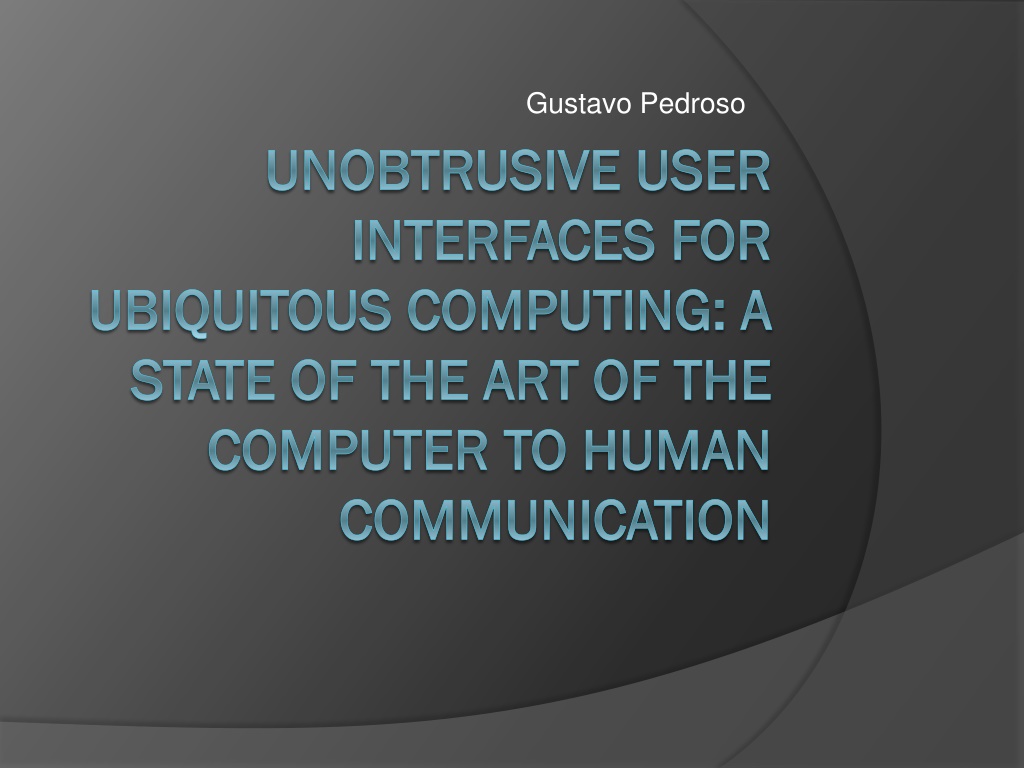
Unobtrusive User Interfaces for Ubiquitous Computing: State of the Art
Explore unobtrusive user interfaces for ubiquitous computing, focusing on Calm Technology and user reactions to different UI types. Discover practical applications, experimental hypotheses, and the potential future of discreet UI design.
Download Presentation

Please find below an Image/Link to download the presentation.
The content on the website is provided AS IS for your information and personal use only. It may not be sold, licensed, or shared on other websites without obtaining consent from the author. Download presentation by click this link. If you encounter any issues during the download, it is possible that the publisher has removed the file from their server.
E N D
Presentation Transcript
Gustavo Pedroso UNOBTRUSIVE USER UNOBTRUSIVE USER INTERFACES FOR INTERFACES FOR UBIQUITOUS COMPUTING: A UBIQUITOUS COMPUTING: A STATE OF THE ART OF THE STATE OF THE ART OF THE COMPUTER TO HUMAN COMPUTER TO HUMAN COMMUNICATION COMMUNICATION
Overview Calm Technology to describe the type of interface for ubi comp that would allow a system to pass info to a user w/o engaging his full attention in a stressful manner. (Mark Weiser & John Seely Brown) Ubi comp describes computing anywhere and everywhere, with many computing devices per user.
http://www.thedigitalape.com/culture-and-technology/minority-report-personalised-advertising-becomes-a-reality/http://www.thedigitalape.com/culture-and-technology/minority-report-personalised-advertising-becomes-a-reality/
Users reaction to the type of UI that we can expect in ubi comp. Purpose of experiment is to test 4 hypotheses about ubi interfaces Most important: People prefer desktop over ubi interfaces to display everyday info Different objects are only good at conveying certain types of info, given their properties (AD Pg 2)
How people react to an output device that is already ubiquitous in its presence Observe how the monitors captured the interest of the public, if at all, namely through studying the placement, size and content the monitors displayed Displays are practically not looked at. Displays must be at eye level. The conclusions of this paper give an insight into design principals for how unobtrusive interfaces may capture the attention if necessary, or on the contrary how to hide an interface
Practical Applications Approaches to awareness of energy consumption The World as a User Interface: Augmented Reality for Ubi comp ActiveBelt: Belt-type Wearable Tactile Display for Directional Navigation (AD Pg 5)
Outcome of study Not well defined and active area of research General trend to keep the UI discreet, even invisible when not needed, the idea that it must be natural Big potential for the future
Source Alistair Doswald DIUF Department of Informatics University of Fribourg, Switzerland alistair.doswald@unifr.ch https://diuf.unifr.ch/main/pai/sites/diuf.uni fr.ch.main.pai/files/education_seminar_u nobtrusiveuserinterfaces_adoswald.pdf
